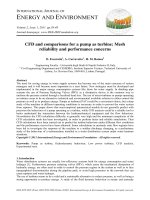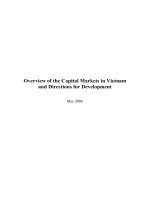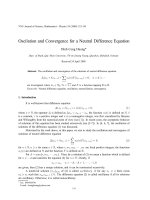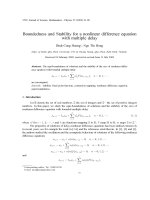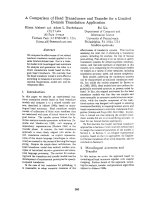Posner weyl radical markets; uprooting capitalism and democracy for a just society (2018)
Bạn đang xem bản rút gọn của tài liệu. Xem và tải ngay bản đầy đủ của tài liệu tại đây (3.26 MB, 194 trang )
RADICAL MARKETS
Radical Markets
Uprooting Capitalism and Democracy for a
Just Society
Eric A. Posner and E. Glen Weyl
PRINCETON UNIVERSITY PRESS
PRINCETON AND OXFORD
Copyright © 2018 by Princeton University Press
Published by Princeton University Press,
41 William Street, Princeton, New Jersey 08540
In the United Kingdom: Princeton University Press,
6 Oxford Street, Woodstock, Oxfordshire OX20 1TR
press.princeton.edu
Jacket design by Karl Spurzem
All Rights Reserved
ISBN 978-0-691-17750-2
Library of Congress Control Number: 2017964479
British Library Cataloging-in-Publication Data is available
This book has been composed in Adobe Text Pro and Gotham
Printed on acid-free paper. ∞
Printed in the United States of America
10 9 8 7 6 5 4 3 2 1
To the memory of William S. Vickrey
CONTENTS
Acknowledgments ix
Preface: The Auction Will Set You Free xiii
Introduction: The Crisis of the Liberal Order 1
1 Property Is Monopoly 30
2 Radical Democracy 80
3 Uniting the World’s Workers 127
4 Dismembering the Octopus 168
5 Data as Labor 205
Conclusion: Going to the Root 250
Epilogue: After Markets? 277
Notes 295
Index 319
ACKNOWLEDGMENTS
Economic production and development are fundamentally social, not individual, processes, or so we
argue throughout this book. Intellectual products such as this book are no different. The social milieus
in which we developed and the wide range of communities to which we have belonged shaped our
ideas and, if this book has the impact we aspire to, the zeitgeist will doubtless be far more important
than our intellectual exertions. Yet there are many people among these broader forces who especially
contributed to this work.
While we identify many of our most important intellectual influences in the course of the book,
each of us had personal intellectual mentors who go less noted there, but merit our thanks. Gary
Becker and especially José Scheinkman played critical roles in encouraging Glen to pursue his
boldest ideas, despite the costs to his professional standing and the difficulty publishing this work.
Jerry Green, Amartya Sen, and especially Jean Tirole were central to shaping Glen’s view of
mechanism design as a force for social transformation. Jennifer Chayes, Glen’s supervisor at
Microsoft, gave him the professional space, interdisciplinary environment, and personal inspiration
he needed to believe in and pursue this project. Eric is grateful for the support of his colleagues at the
University of Chicago, and to the Russell Baker Scholars Fund for financial support. Glen is grateful
to the Alfred P. Sloan Foundation for financial support through his fellowship.
We owe a special debt to Soumaya Keynes, whose interest in and enthusiasm for the merging of
our various ideas helped stimulate us to write this book.
The many co-authors and collaborators on projects that contributed to our vision here are cited
throughout, but a few deserve explicit mention here: Anthony Lee Zhang pioneered the idea of the
common ownership self-assessed tax with Glen; Steve Lalley proved the fundamental theorems about
Quadratic Voting with Glen, and Nick Stephanopoulos together with Eric devised the practical vision
of egalitarian election law based on it; Fiona Scott Morton devised the 1% rule for institutional
investors with us; and Jaron Lanier has been Glen’s partner every step of the way in Data as Labor.
Our editor Joe Jackson and his colleagues at Princeton University Press made this book a reality.
Susan Jean Miller did a superb job helping us hone our prose. We are also grateful to a talented team
of research assistants. Graham Haviland, Eliot Levmore, Stella Shannon, Han-ah Sumner, and Jill
Rogowski provided invaluable assistance.
A conference on our manuscript hosted by the Cowles Foundation at Yale University and
supported enthusiastically by its director Larry Samuelson helped shape our thinking. Seven
discussants (Ian Ayres, Dirk Bergemann, Jacob Hacker, Nicole Immorlica, Branko Milanovic, Tim
Shenk, and Matt Weinzierl) provided us vital feedback. Tim was particularly helpful in shaping our
understanding of the relevant history of ideas. We also received comments from many friends and
colleagues, including Anna Blender, Charlotte Cavaille, Patrick Collison, Adam Cox, Richard
Eskow, Marion Fourcade, Alex Peysakovich, Greg Shaw, Itai Sher, Steve Swig, Tommaso Valetti,
and Steve Weyl. Steph Dick and Chris Muller provided thought-provoking reactions that shaped our
revisions. Richard Arnott, Bill Vickrey’s archivist, shaped our understanding of his ideas and beliefs.
Dionisio Gonzalez, Tod Lippy, and Laura Weyl supported us in thinking through the aesthetics of the
book. We also appreciate the collaboration of the members of the “Radical Economics” and “Social
Life of Data” reading groups at Microsoft, especially Nicky Couldry, Dan Greene, Jessy Hwang,
Moira Weigel, and James Wright.
Encouragement from Satya Nadella and Kevin Scott, business leaders at Microsoft, and Atif Mian
and Ken Rogoff from the academic side, has also been important to the development of this work.
Glen is grateful to his wife, Alisha Holland, more than anyone. She suffuses this book from start
to finish; as only she will recognize, this book doubles as a sort of love letter. She was the one who
brought Glen to Rio and got him thinking about favelas, and it was she who encouraged him to
develop the ideas of the epilogue. The spirit of the city and the migrant, and the passion to improve
the lot of both, that animate so much of our work come from her. Glen and Alisha’s two-person
writing group transformed much of our writing. Without Alisha’s support of Glen’s professional risks
and iconoclasm he would not have dared write this book; without the empathy and appreciation for
beauty she taught him, he never could have had the vision to do so. Every day Glen discovers more
how interwoven and inseparable their ideas and emotions are. Building that bond, starting as isolated
and nerdy adolescents, has not always been easy or comforting. But just like a society, a partnership
that can radically reform itself in the face of crisis, and thus foster rather than constrain equality,
growth, and cooperation, is a partnership that deserves to last.
PREFACE
The Auction Will Set You Free
The nineteenth-century liberal was a radical, both in the etymological sense of going to the root of
the matter, and in the political sense of favoring major changes in social institutions. So too must
be his modern heir.
—MILTON FRIEDMAN, CAPITALISM AND FREEDOM, 1961
The seed of this book was planted during a summer one of us spent in Rio de Janeiro. Rio is the most
naturally beautiful city in the world. Lush tropical hills, which roll down to an island-laden bright
blue bay, afford unrivaled views. Yet these same hills are covered with favelas, squalid jerry-rigged
slums that lack basic sanitation and transportation.
Leblon, possibly the wealthiest neighborhood in all of Latin America, lies at the base of the hills.
There your money can buy, at wildly inflated prices, the luxury watches and cars that are leading
status symbols. Yet the citizens of Leblon don’t dare wear their watches on the street, nor stop their
cars at red lights at night, for fear of the violence looming from the favelas above. Rio is one of the
most dangerous cities in the world.
Cariocas, as the people of Rio call themselves, are relaxed, kind, creative, and open. They
perceive race more subtly than we do in the United States, with our sharp line between white and
black. Both countries have long histories of slavery, but in Brazil, everyone is of mixed heritage.
Even so, variations in skin tone convey gradations of class, an omnipresent force in Brazilian society.
Economically, Brazil is the most unequal country in the Western hemisphere. While it overflows
with natural abundance, a few families control much of its wealth and almost 10% of Brazilians live
below the global poverty line. The last president was ejected for abusing her power, her predecessor
is in jail for corruption, and corruption investigators are closing in on the current leader, whose
approval rating is in single digits. He will probably be jailed by the time this book is published.
Living standards in the country have stagnated for long periods. Entrepreneurship is sparse.
Why has this paradise fallen? How can its potential be fulfilled? The debate is familiar.
LEFT: The
government should tax the rich to supply homes, medical care, and jobs for the poor.
RIGHT: Yes, and you end up with Venezuela or Zimbabwe. The government needs to privatize
state-owned industries, enforce property rights, lower taxes, and reduce regulation. Get the
economy going, and inequality will take care of itself.
TECHNOCRATIC MIDDLE: We need an economy carefully regulated by internationally trained
experts, targeted interventions that have been tested by randomized controlled trials, and
political reform that protects human rights.
People in rich countries, where inequality is rising, will recognize Brazil in their own countries.
In the rich countries, economies are also stagnating and political conflict and corruption are on the
rise. The long-standing belief that a “developing country” like Brazil will eventually end up as a
“developed country” like the United States is under scrutiny, and people are beginning to wonder if
things are moving in reverse. Meanwhile, the standard prescriptions for reform are the same as they
have been for the last half century: increase taxes and redistribute; strengthen markets and privatize;
or improve governance and expertise.
In Rio, these prescriptions are palpably stale. Poverty, tight and concentrated control of land, and
political conflict seem to be intimately linked. Wealth redistribution has made few inroads on
inequality. Improvement of property rights has not done much to foster development. Slum dwellers
hang on to property that could instead be a public park, a nature preserve, or modern housing. Land in
the city center, where favela dwellers could live decently and have access to public services, is
monopolized by the wealthy, who are too fearful of crime to enjoy it. The same concentrated control
of wealth that breeds inequality seems to corrupt politics and restrain business initiative: Brazil is in
the bottom 10% of countries in terms of ease of creating a business, according to the World Bank.
The case of Rio demands an answer to the question: Is there no better way? Can this city not
escape inequality, stagnation, and social conflict? Does Rio foreshadow the fate of New York,
London, and Tokyo, except without the pleasures of samba and beaches?
Auctions as Radical Markets
The problem stems from ideas, or rather the lack thereof. The arguments of both the Right and the Left
had something to offer when they originated in the nineteenth and early twentieth centuries, but today
their potential is spent. No longer bold reforms, they box us in. To open up our social possibilities,
we must open our minds to radical redesigns. To get to the root of the problem, we must understand
how our economic and political institutions work and use this knowledge to formulate a response,
which is what we do in this book.
Our premise is that markets are, and for the medium term will remain, the best way of arranging a
society. But while our society is supposed to be organized by competitive markets, we contend the
most important markets are monopolized or entirely missing, and that by creating true competitive,
open, and free markets, we can dramatically reduce inequality, increase prosperity, and heal the
ideological and social rifts tearing our society apart.
Like those on the Right, we think that markets must be strengthened, expanded, and purified. Yet
we perceive a fatal flaw in the Right: it has been timid and unimaginative in its vision of the social
changes necessary to make markets flourish. Many on the Right support Market Fundamentalism, an
ideology they assume to have been proven in economic theory and historical experience. In reality, it
is little more than a nostalgic commitment to an idealized version of markets as they existed in the
Anglo-Saxon world in the nineteenth century. (We will use the term capitalism to refer to this
idealized historical version of markets, in which governments focus on protecting private property
and enforcing contracts.) We contrast Market Fundamentalism with Market Radicalism, which is our
own commitment to understand, restructure, and improve markets at their very roots.
We share with the Left the idea that existing social arrangements generate unfair inequality and
undermine collective action. But the Left’s flaw has been its reliance on the discretionary power of
government bureaucratic elites to fix social ills. Imagined by the Left to be benevolent, ideologically
neutral, and committed to the public good, these elites are sometimes arbitrary, corrupt, incompetent,
or, perceived that way whether they are or not, distrusted by the public. To harness the radicalism we
believe is inherent in markets, we must decentralize power while spurring collective action.
The Radical Markets we envision are institutional arrangements that allow the fundamental
principles of market allocation—free exchange disciplined by competition and open to all comers—
to play out fully. An auction is the quintessential Radical Market. Because the rules of an auction
require people to bid against each other, the object on the block winds up in the hands of the person
who wants it most—with the caveat that differences in bids may represent differences in wealth as
well as desire.
Although most people do not think of auctions outside the realm of estate sales, fine art, and fundraisers, they are commonly conducted on the Internet, away from the public eye. But in what follows
we will show how spreading them throughout our society could save Rio—and the world.
Rio for Sale: A Thought Experiment
Suppose the entire city of Rio is perpetually up for auction. Imagine that every building, business,
factory, and patch of hillside has a going price, and anyone who bids a price higher than the going
price for an entity would take possession of it. Auctions might extend to some kinds of personal
property like automobiles, or even to what is normally determined through the political process, like
the amount of pollution that factories are permitted to discharge. Much of this book is devoted to
figuring out how such a system might work.
As a thought experiment, however, let us assume for the moment that the auctions are conducted
via smartphone apps that automatically bid based on default settings, eliminating most of the need for
people to constantly calculate how much to offer. Laws ensure that the obvious sorts of disruptions
don’t occur (for example, coming home to find your apartment is no longer yours). Incentives are in
place to care for and develop assets, and ensure that privacy and other values are also preserved. All
of the revenue generated by this auction would be returned to citizens, equally, as a “social
dividend,” or used to fund public projects, which is how revenues from oil sales in Alaska and
Norway are used.
Life under this auction would transform Rio’s society and politics. First, people would think
about their property differently. The stark distinction between owning a house and occupying a spot
on the beach would erode. Private property would become public to a significant extent and the
possessions of those around you would, in a sense, become partly yours.
In addition, perpetual auctioning would undo the tremendous misuse of lands and other resources.
The highest bidder for the most scenic hillsides would never be someone planning to build rickety
and dilapidated slums. The highest bidder for central city land would not be the developers of small,
ritzy condos but the builders of skyscrapers for the new, vast middle class auctioning would create.
A third result would be the end of the primary source of economic inequality. Although at first
blush you might assume that the auction would allow the rich to buy up everything of value, reflect for
a moment. What do you mean by “the rich”? People who own lots of businesses, land, and so forth.
But, if everything were up for auction all the time, no person would own such assets. Their benefits
would flow equally to all. Chapter 1 explains how.
Fourth, the Rio auction system would limit corruption by taking many major political decisions
away from politicians and placing them in the hands of citizens. With an improved public life, crime
would be reduced, street life would be restored, and the retreat into private communities would
cease. Far from the usual image of markets substituting for and undermining the public sphere,
Radical Markets would bolster trust in public life. Chapter 2 explains how an auction could organize
politics.
Radical Heroes
Our argument draws on an intellectual tradition that goes back to Adam Smith. Smith is frequently
invoked by conservative thinkers these days, including Market Fundamentalists. But Smith was a
radical—in the two ways highlighted by our epigraph. First, he dug deeply into the roots of economic
organization and proposed theories that remain influential today. Second, he attacked the prevailing
ideas and institutions of his day and presented a series of daring propositions and reforms. People
regard these ideas as “conservative” today simply because they were so successful in reshaping
policy and thinking at the time.
Market Fundamentalists draw a line from Smith to people like Friedrich Hayek, Milton Friedman,
and George Stigler—midcentury conservative idols and Nobel laureates who took from Smith an
idealized notion of markets based on private property. They put this vision to work in support of
libertarian economics and politics. The Fundamentalists ignore those economists who share Smith’s
radical spirit, such as Henry George, whose ideas helped launch the Progressive era and who may
have been the most widely read economist of all time, but whose vision was lost in the Left-Right
battles of the Cold War. George was more concerned about inequality than were the conservative
followers of Smith, and he recognized that private property could stand in the way of truly free
markets. To remedy this problem, he proposed a tax scheme that would create a system of common
ownership for land.
The most important “Georgist” economist, to whose memory we dedicate this book, is a midtwentieth-century professor named William Spencer Vickrey. Vickrey, pictured in figure P.1, was the
Master Yoda of the economics profession: silly, carefree, reclusive, absent-minded, and a fount of
often inscrutable yet world-changing insights. He roller-skated from the train to class and wore his
lunch on his shirts. He might wake from a nap in the middle of research workshops to comment, “This
paper would benefit from … Henry George’s principle of taxing land values.” He mentioned
George’s scheme so often that a colleague who was eulogizing him quipped, “I imagine by now he
has mentioned it to God, too.”1 Also aloof, arrogant, and private, Vickrey often failed to publish
academic articles that contained his best ideas.
The inspirations of Vickrey’s research closely resembled ours. He focused during most of his
career on the organization of cities and the tremendous waste of resources in most urban forms. He
was particularly fascinated by cities in Latin America, where he advised governments on urban
planning and taxation. It was while he was designing a fiscal system for Venezuela that he produced
the paper that finally undermined his best efforts at ensuring his obscurity.
That paper was published in 1961. Its title, “Counterspeculation, Auctions, and Competitive
Sealed Tenders,” seemed to ensure it would soon be forgotten. But it was rediscovered a decade
later. Vickrey’s paper was the first to study the power of auctions to solve major social problems,
helped found a field of economics called “mechanism design,” and earned him the Nobel Prize in
1996.
FIGURE P.1: William S. Vickrey (1914–1996), Nobel Laureate in Economics, father of mechanism design, and quiet hero of our
drama. Photo by Jon Levy, permission granted by Getty Images.
Vickrey’s ideas have transformed economic theory and had an impact on policy. Governments
around the world use auctions based on Vickrey’s ideas to sell licenses to use radio spectrum.
Facebook, Google, and Bing use a system derived from Vickrey’s auction to allocate advertising
space on their web pages. Vickrey’s insights about urban planning and congestion pricing are slowly
changing the face of cities, and they play an important role in the pricing policies of ride-hailing apps
like Uber and Lyft.2
However, none of these applications reflects the ambition that sparked Vickrey’s work. When
Vickrey won the Nobel Prize, he reportedly hoped to use the award as a “bully pulpit” to bring
George’s transformative ideas and the radical potential of mechanism design to a broader audience.3
Yet Vickrey died of a heart attack three days after learning of his prize. Even had he lived, Vickrey
may have struggled to inspire the public. In 1996, economies were booming around the world and a
new era of global cooperation seemed to be dawning. No one wanted to tinker with success and
Vickrey’s approach faced daunting practical obstacles.
Today, however, the outlook for economic and political progress is no longer sunny, while,
thanks to developments in economics and technology, the practical limits on Vickrey’s approach can
now be overcome. This book, therefore, tries to act as Vickrey’s lost bully pulpit, fleshing out the
vision he might have shared with the world had he lived.
RADICAL MARKETS
Introduction
THE CRISIS OF THE LIBERAL ORDER
The ideas of economists and political philosophers, both when they are right and when they are
wrong, are more powerful than is commonly understood. Indeed the world is ruled by little else.
Practical men, who believe themselves to be quite exempt from any intellectual influence, are
usually the slaves of some defunct economist.
—JOHN MAYNARD KEYNES, THE GENERAL THEORY OF EMPLOYMENT, INTEREST, AND MONEY, 1936
The Berlin Wall fell when one of us was just starting preschool and the other was beginning his
career, that moment was crucial in shaping our political identities. The “American way”—free
markets, popular sovereignty, and global integration—had vanquished the Soviet “evil empire.”
Since then those values—which we will call the liberal order—have dominated intellectual
discussions. Leading thinkers declared “the end of history.” The great social problems that had so
long been the center of political drama had been solved.1
Both of us came of age intellectually in an unprecedented era of global intellectual consensus,
confidence, and complacency. Nowhere was this atmosphere clearer than in the policy world in
which we each ended up—one of us in law, the other in economics. Ironically, economics, more than
any other field, took on the mantle of leadership in a world where debates over economic systems had
disappeared. Economists, who at one time had helped define the extremes of the political spectrum
(remember Karl Marx?), saw themselves as mainstream voices of reason, entrusted by the public
with policy decisions.2
In universities and professional associations, economists focused on centrist policy analysis,
which, being highly mathematical and quantitative, appeared to be ideologically neutral. Meanwhile
the field marginalized those on the radical left (Marxists) and right (the so-called Austrian school). 3
Most of the work done by academics in the areas of economics, law, and policy were devoted to
justifying existing market institutions or offering moderate reforms that, in essence, preserved the
status quo.
With few exceptions, mainstream economists of this era assumed that the prevailing design of
market institutions was working about as well as possible. If markets “failed,” the theory went,
moderate regulation, based on cost-benefit analysis, would pick up the slack. Questions about
inequality were largely ignored. Economists believed that because markets generated so much wealth,
inequality could be tolerated; a social safety net ensured that the worst off didn’t starve. One of us
ended up working at Microsoft, pursuing his interest in extending the standard approach to modern
technology platforms, and the other focused on questions of legal reform. Meanwhile, the ground was
shifting beneath our feet.
The financial crisis of 2008 and the subsequent recession were the first tremors. Yet even though
the economic downturn was the worst since the Great Depression, for a time it seemed to be no
different from most recessions. People lost their homes, jobs, and access to credit, but this had
happened many times before and the economy had recovered. Only in 2016 did it become clear how
dramatically things had changed.
It turned out that a great deal of the economic progress that had taken place before the recession
was illusory—it had benefited mostly the very rich. Ballooning inequality, stagnating living
standards, and rising economic insecurity made a mockery of the old style of policy analysis. The
angry political reaction to the recession—exemplified in the United States by the Occupy Wall Street
and Tea Party movements—did not subside as the economy recovered. The public lost faith in the
mainstream policy analysis of elites who had supported financial deregulation and then the unpopular
bailouts. With the old ways of doing things in doubt and new directions unclear, public opinion
polarized. And because of long-simmering controversies over cultural issues, especially immigration,
anger at the elites took an ugly nativist turn. Xenophobia and populism at a level not seen since the
1930s erupted across the world.
Unfortunately, ideas have not kept up with the crisis. Capitalism is blamed for increased
inequality and slowing growth, yet no alternative has presented itself. Liberal democracy is blamed
for corruption and paralysis, but authoritarianism is hardly an appealing substitute. Globalization and
international governance institutions have become favorite scapegoats, yet no other sustainable path
for international relations has been proposed. Even the best-run governments of the most advanced
countries rally around the mainstream technocratic approach of the past despite its many failures.
In searching for a way out of this impasse, we have thus found ourselves rereading the works of
the founding fathers of modern social organization: a group of self-styled “political economists” and
“Philosophical Radicals” of the late eighteenth and nineteenth centuries, including Adam Smith, the
Marquis de Condorcet, Jeremy Bentham, John Stuart Mill, Henry George, Léon Walras, and Beatrice
Webb.
Although these thinkers—whose ideas we will explore in later chapters—lived in a world
different from ours, they faced some similar challenges. The economic and political system they had
inherited from the eighteenth century could not keep up with changes in technology, demographics, the
globalization of the time, and the larger cultural environment. Entrenched privilege blocked efforts to
promote equality, growth, and political reform. Believing the intellectual resources of the day were
insufficient to provide a way forward, the Philosophical Radicals developed new ideas that have
played an enormous role in the development of our modern market-based economic system and of
liberal democracy. Their vision and reforms combined the libertarian aspirations of today’s right
with the egalitarian goals of today’s left and are the shared heritage of both ends of the standard
political spectrum. This is the common spirit we seek to revive.
Inequality
The most significant problem of our time is the rising inequality within wealthy countries. Figure I.1
shows the evolution of the share of income earned by the top 1% of the income distribution in the
United States from 1913 to 2015.4 The figure shows this share both before and after taxes. Focusing
on the after-tax figure most relevant to final consumption, we see that the share of income taken by the
top 1% of earners has roughly doubled from its trough of 8% in the mid-1970s to its recent peak of
16%. A similar pattern, though less dramatic, prevailed in many other Anglo-Saxon countries during
this period. Income patterns were more muted in some continental European and East Asian countries
where government redistribution is more generous.5
FIGURE I.1: US income shares of top 1% households, including capital gains, before and after taxes.
Source: Thomas Piketty, Emmanuel Saez, & Gabriel Zucman, Distributional National Accounts: Methods and Estimates for the United
States, Quarterly Journal of Economics (Forthcoming).
Is this growth in inequality simply the price of a dynamic economy, as suggested by many
“neoliberal” economic arguments? Some economists have argued that growing inequality reflects the
diverging skills and opportunities of the talented, skills that will go to waste if not rewarded by rising
income. Yet rising inequality does not reflect only diverging wages, but the shift of national income
away from wages entirely. Figure I.2 shows the share of national income that accrues to all labor,
from factory workers to CEOs, what economists call the “labor share.” There has been a nearly 10%
drop over this same period in the share of national income in the United States that rewards work,
bringing the United States closer to developing countries where labor’s share is far lower than has
traditionally been the case in rich countries.
FIGURE I.2: Labor’s share of US National Income over time.
Source: David Autor, David Dorn, Lawrence F. Katz, Christina Patterson, & John Van Reenen, The Fall of the Labor Share and the
Rise of Superstar Firms (MIT Working Paper, 2017), />
Where has the money that used to pay workers gone? If it were rewarding saving, that might not
be so worrying. After all, any citizen can choose to save, and rewarding saving can stimulate growth.
Yet increasing evidence suggests that the reward to saving is itself falling (as evidenced by falling
interest rates) and instead an increasing fraction of national income is being absorbed by market
power—what we later call the “monopoly problem.”6 Figure I.3 illustrates the trend.
The top panel of figure I.3 shows the share of US national income accounted for by “economic
profits” above what would be expected under perfect competition, profits attributable to monopoly
power. Such excess profits have risen roughly fourfold just since the early 1980s, in tandem with
rising inequality and declining labor share.7 These profits are overwhelmingly claimed by the
extremely wealthy. As we argue below, the rise in inequality and the fall in labor’s share are both
fueled by and fuel a rich-get-richer dynamic. Sixty percent of the income of the top 1% of earners
comes from such profits or returns on capital (as opposed to wages), four times as large a fraction as
for the bottom 90% of income earners. The bottom panel of the figure shows the co-evolution of
another measure of market power (the excess price or “markup” firms charge over cost) and the stock
market value of corporations.8 The close coincidence of these series, and the tight correlation the
authors found between market value and markups across companies in a given year, strongly suggest
that falling labor’s share and rising inequality are not simply the necessary consequence of
accelerated growth. Instead, they are close correlates (symptoms, causes, or likely both) of increased
market power.
FIGURE I.3: Above—competitive profits as a fraction of national income in the United States over time. Below—markups over cost
(black) and average share-weighted stock market value (gray).
Sources: Simcha Barkai, Declining Labor and Capital Shares (2017),
and Jan de Loecker & Jan Eeckhout, The Rise of Market
Power and Macroeconomic Implications (2017), />
The trajectory of inequality across countries is a different story. Figure I.4 shows the fraction of
global inequality, measured by the common “mean logarithmic deviation” (discussed further in
chapter 3), that prevailed between, rather than within, countries from 1820 to 2011. From 1820 to
1970, inequality between countries grew nearly tenfold; in contrast, inequality within countries
declined by about a fifth. This pattern has reversed since 1970; international inequality has fallen by
about a fifth and domestic inequality within wealthy countries has risen.
Again, if this international inequality were an outgrowth of dynamic international markets, it might
be worth its price. Yet, the fact that international inequality began to fall just as globalization began to
accelerate and decolonization was completed suggests that international inequality may be
attributable to colonialism and closed international markets rather than to free markets.
Stagnation
The last significant shift in economic philosophy took place in the 1970s, when “stagflation”
(simultaneously high inflation and unemployment) undermined the then-accepted Keynesian argument
that inflation was a cost worth paying for full employment. The neoliberal and “supply-side” ideas
that grew up in response promised that allowing greater play of capitalism (lower taxes, deregulation,
privatization) would unleash economic growth. Even if capitalism might cause some inequality,
wealth would eventually “trickle down” to ordinary workers. Yet not only has the promised wealth
failed to trickle down; it has not materialized at all. In fact, productivity growth has dramatically
fallen over this period. For example, in the United States, the growth in labor productivity from the
end of World War II until 2004 was around 2.25% annually. Since 2005, productivity growth has
slowed by a full percentage point, to around 1.25%.9
FIGURE I.4: Global inequality that is across as opposed to within countries from 1820 to 2011, measured by the mean logarithmic
deviation (see chapter 3).
This series is based on a merger of the data of François Bourguignon and Christian Morrisson, Inequality Among World Citizens: 1820–
1992, 92 American Economic Review 4 (2002), and Branko Milanovic, Global Inequality of Opportunity: How Much of Our Income Is
Determined by Where We Live?, 97 Review of Econonomics & Statistics 2 (2015), performed by Branko Milanovic as a favor to us.
FIGURE I.5: Average annual real productivity growth around the world for various regions or countries and time periods, 1950–2013.
Source: OECD.
This phenomenon has been less dramatic in the United States than in other wealthy countries.
Figure I.5 shows productivity growth in countries around the world beginning in 1950.10 Overall,
productivity growth has dramatically fallen since midcentury, with the exceptions of the 1995–2004
period in certain wealthy countries and the different trend observed in developing countries. In many
wealthy countries, such as France and Japan, productivity growth fell by a factor of 10, from 5% to
7% during the period from 1950 to 1972 to just a fraction of a percent in the last decade. Recent data
paint an even more discouraging portrait.11
A related problem concerns the key economic resources of labor and capital, which are marked
by widespread unemployment (in the case of labor) or misallocation (in the case of capital). This
aspect of sluggish economic growth has independent significance because unemployment and low
wages cause social and political conflict. Unemployment and misemployment differ from country to
country, depending on the treatment of the long-term unemployed. In Europe, unemployment rates have
risen, while in the United States, prime-aged males are dropping out of the labor force. For example,
the labor force participation rate of prime-aged US men fell from 96% in 1970 to 88% in 2015. In
most countries in Europe, unemployment has risen from rates of 4% to 6% midcentury to a persistent
10% or higher rate.12 And it is not only labor that is underused in today’s economy. Recent research
indicates that capital assets are misallocated across firms as well, in the sense that capital is not
employed by the firms, sectors, or cities that could make most valuable use of it.13 This suggests that
reallocating capital and employment from less productive entities to more productive ones could
dramatically increase aggregate output.14
Together, the trends of rising inequality and stagnating growth mean that typical citizens in
wealthy countries are no longer living much better than their parents did. Economist Raj Chetty and
co-authors found that while 90% of American children born in 1940 had a higher living standard than
their parents, only 50% of children born in 1980 did.15 Similar figures are not yet available for other
wealthy countries, but these patterns likely characterize them as well.
These trends pose the same problem for the neoliberal economic consensus that stagflation posed
for the Keynesian consensus before it. We were promised economic dynamism in exchange for
inequality. We got the inequality, but dynamism is actually declining. Call it stagnequality—lower
growth combined with rising inequality rather than inflation. It is no surprise, then, that the public has
rejected conventional economic wisdom.
Conflict
Given that leftists have long criticized “trickle-down economics,” it would be natural to expect a
leftist populist backlash to stagnequality and a subsequent move to redistribute income. To some
extent this prediction has been confirmed by recent events, as summarized in table I.1. Bernie Sanders
nearly won the US Democratic primary despite identifying as a socialist earlier in his life and running
for president as a social democrat. In the UK, Labor Party leader Jeremy Corbyn is the most left-wing
leader of Britain’s Labor Party with a serious chance of victory since World War II, and left-wing
movements in France and Italy have achieved unusual political success.
However, history has shown that fascist or ultranationalist movements have come to power when
the social fabric is fraying. Promising to claim wealth for the masses, not from the rich, but from an
external enemy or from an internal “other,” a vulnerable minority group, reactionary movements often
turn their fury outward, threatening international stability. Although discredited for a time by the
Holocaust and World War II, there are troubling signs of their revival.
A s table I.1 shows, rightist movements have gained greater traction at ballot boxes and in
achieving political goals than have leftist movements.16 In the United States, the UK, and Russia these
movements have either taken control of government, achieved significant influence over government,
or achieved concrete political ends. In France and Italy, they have come close. One has to reach far
back in the history of the countries they affect to find a precedent for them. Japan, France, Germany,
Italy, and Australia have not seen such movements gain this level of success since World War II.
While the United States has a rich populist tradition, Donald Trump is the first true populist president,
a man with no experience in political or military office. Trump attacked fundamental political
institutions with incendiary language on the campaign trail and in office, something no other president
has done, with Andrew Jackson as the arguable exception.17
TABLE I.1: Anti-establishment, illiberal, and populist movements in the ten largest economies in the world with above-average living
standards, ordered in descending size, by 2016 International Monetary Fund nominal Gross Domestic Product
Right-wing populist movements appeal to historically dominant population groups that have been
left behind economically relative to their expectations: the poorly educated, those who live in rural
areas, and workers who have lost jobs because of international trade.18 Arguments made by the
leaders of right-wing populist movements for trade barriers and immigration restrictions fall on
willing ears. But rather than explicitly appeal to class identity or distributive justice, the leaders of
right-wing populist movements appeal to the ethnonationalist creed of “blood and soil.” These groups
look nostalgically back to a past when people like them enjoyed greater economic security and higher
status.
Right-wing populist movements bring out into the open the underlying problems with the systems
they challenge. They simultaneously reflect and further heighten the high levels of political
polarization, threatening the political stability of democratic countries.19 The movements offer little in
terms of realistic policy proposals that would benefit their members as well as the general public;
they are protesting against the failures of existing political systems rather than acting as a positive
force.20 The rise of these movements, then, reflects a failure of democratic institutions to advance the
public interest and resolve conflicts between different social groups.
Today’s right-wing movements come into conflict with those who do not share their narrowly
defined identity. White, male, working-class earnings are stagnating in wealthy countries, while
women, ethnic and racial minorities, and people in developing nations are enjoying relative
advances.21 Rightist leaders blame the economic success of minorities for the problems that are
oppressing working-class white men and promise that “taking back” the increased wealth of poor
countries will solve them.
Within wealthy countries, movements assert rights for women and a variety of minorities. In
developing countries, nationalistic movements of another sort have been gaining strength. Many rising
powers (China, India, Turkey, Mexico) have seen an increase in authoritarian and nationalist
sentiment, driven in many cases by leaders accusing Western-dominated international institutions of
holding back their countries. A collision seems to be looming between the demands for economic
progress in developing countries and the increasingly nationalistic politics of wealthy countries.
Many of these domestic and international political conflicts relate to the difficulty of
democratically resolving issues that pit the fundamental concerns of minority groups against the less
pressing interests of majority groups. These issues have important economic foundations but are often
formulated in social and cultural language that clearly marks the right-wing leader as being on the
side of a particular group.
In the United States, for example, gun rights, religious liberty, and the right of the wealthy to
contribute to political campaigns animate the Right, while the identity politics of minority groups and
civil liberties inspire the Left. Attempts to resolve these issues often end up in the hands of the
judicial system. But judges are members of the elite and tend to be out of touch with what life is like
for many ordinary citizens. Their decisions often inflame rather than settle cultural disputes.
On the international stage, institutions, such as the World Trade Organization and the European
Union, which were designed to help resolve the tensions between national sovereignty and
international order, are increasingly seen as illegitimate, unresponsive, and unable to balance the
interests of richer and poorer countries. In short, governance institutions around the world face a
crisis of legitimacy.
The Markets and Their Discontents
The heroes of our story, the Philosophical Radicals, came to prominence in the face of a constellation
of woes closely related to those we are seeing today. They saw aristocratic privilege restraining
markets as the problem. Their goals were to free markets from the control of feudalistic monopolists
whose hoarding of land impeded productivity and concentrated wealth; to create political systems
responsive to popular sentiment and able to resolve internal conflict; and to establish an international
system of cooperation that would benefit the general population of countries and undermine
traditional elites. This is precisely the sort of movement that our present crisis calls for.
The spirit of the market form of organization appears most famously in the late-eighteenth-century
writings of Adam Smith. Smith saw markets as settings where “It is not from the benevolence of the
butcher, the brewer, or the baker, that we expect our dinner, but from their regard to their own
interest.”22 While now a cliché, the notion that self-interested behavior led to the public good was
shocking at the time because it contrasted so sharply with common experience.
In the past, most individuals lived their lives within small, tight-knit communities where moral
impulses, social shame, gossip, and empathy provided the primary incentives for individuals to
accommodate themselves to the common good. Economists and sociologists sometimes call these
communities “moral economies.”23 Self-interested behavior was of course common and unavoidable
but was regarded as an unfortunate consequence of the fallen nature of human beings rather than as a
source of prosperity. Religion served to constrain such deviance at every turn. The virtuous were
farmers, craftsmen, soldiers, and valiant aristocratic warriors, who followed an age-old way of life
for its own sake or to please God. Merchants, financiers, and others who amassed wealth from
“commerce” were regarded with suspicion well into the nineteenth century.
Even today, moral economies flourish in approximate form outside the cities and govern our
relationships with close friends and family. An idealized portrait of such a society is Frank Capra’s
1946 classic film It’s a Wonderful Life . George Bailey (played by Jimmy Stewart) is a banker
motivated less by profit than by the needs of his small community, which he is able to serve thanks to
his intimate knowledge of his fellow townsfolk. When trouble comes with the onset of the Great
Depression, the community reciprocates his altruism and saves him and his bank from ruin. Smithian
capitalism—embodied by a greedy, amoral competitor, Mr. Potter, who finances slums and exploits
his customers—is portrayed as a threat to the community. The sense of mutual support between
Bailey’s bank and the town attests both to the economic efficiency of the moral economy and its
intrinsic value.
Smith’s critics have emphasized the real advantages of moral economies over markets. 24 Market
prices cannot detect, account for, reward, or punish the many ways in which individual actions affect
others. In a market economy, if a homeowner beautifies her house, she raises the value of her
neighbor’s property, but the market rewards her only for the increase in her own home’s value, not for
the benefits to her neighbor. In a moral economy, the same homeowner would be rewarded by her
greater standing in town and the appreciation of her neighbors, who will reciprocate in some way. In
a market economy, a business that sells defective products may eventually suffer some reputational
costs, but usually will profit for years. In a moral economy, the business owner would be run out of
town. Governments try to step into the shoes of the village gossip, but the regulations and rulings their
bureaucrats and judges hand down are never as responsive to local conditions as community members
are.
Despite these advantages, moral economies break down as the scope and scale of trade expand.
We benefit from mass production and global supply chains because fixed costs of production are
spread over millions of people and we can draw on diverse skills and inputs from around the world,
resulting in delightful products at very low prices. But if millions of people worldwide consume a
product, it is impractical for them to coordinate a boycott—except in unusual cases—if the product is
hazardous or of low quality. Moreover, mass production requires merchants to trade over long
distances, with strangers, and this means that personal reputation cannot ensure that contracts are kept.
A modern market economy—which combines government support for trade (contract and property
law) along with government protection against abuses (tort law and regulation)—generates value far
beyond the capabilities of a moral economy. Because of these limitations, moral economies can feel
constraining and antiquated when confronted with large-scale market societies. Unable to account for
the needs of those far away, they may become hostile to outsiders and intolerant of internal diversity,
fearing it will erode group values.
From The Scarlet Letter to Sister Carrie, a dystopian vision of moral economies has been a
fixture of American literature. The 2017 video adaptation of Margaret Atwood’s novel The
Handmaid’s Tale depicts the reestablishment of a strict moral economy in the United States, where
fertility rates have drastically fallen. The small minority of women who remain fertile are held in
reproductive slavery and ritualistically raped by ruling-class men who are perverted and degraded by
this arrangement and the strictures intended to prevent them from abusing their power. Diversity of
opinion and lifestyle is ruthlessly suppressed as the enslaved women and their male counterparts are
forced to constantly monitor one another.
These cautionary tales have not quashed the ideal of moral economies for the far Right, and even
for certain nostalgic leftists. But since the era of mass production started in the nineteenth century,
only a handful of idiosyncratic and religiously based communities, such as the Amish, have managed
to sustain moral economies, which operate mostly outside of the market.
The major alternative idea, and the force behind the politics of the far Left, is central planning, as
we discuss in the next chapter. Marxists believed that state ownership of capital and control of
